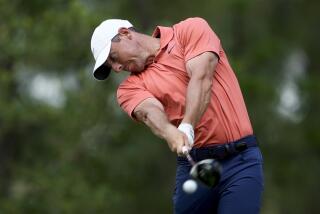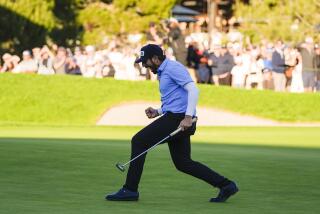As Usual, Winner Didn’t Throw Caution to Wind
- Share via
PEBBLE BEACH, Calif. — Tom Kite winning an Open is Spencer Tracy winning an Oscar, an honest man winning an election, a President a popularity contest. It’s so fitting, you’re surprised it happened.
That sound you hear is the monkey falling off Tom’s back.
You see, right up to 5 p.m. Sunday, most of us thought it was Kite’s impossible dream.
Tom, we all felt sure, was going to join that forlorn group of deserving achievers who never attained the pinnacle of success--Sam Snead, who never won a U.S. Open; Ernie Banks, who never played in a World Series. He was history’s stepchild. He was snake-bit.
He was the leading money-winner of all time with $7,114,440 (to which you now add $275,000 for winning the Open). He had won 16 tournaments. But none of them fitted under that arbitrary definition “major.”
Golf prowess is measured three ways: 1) money won; 2) tournaments won; and 3) “majors” won. It got to be an embarrassment to Tom Kite. So much so that only the day before his great triumph, he spent snappish minutes lecturing the press on the notion that, “Just because I’ve never won a major doesn’t mean I’m suicidal.” An interesting disclaimer because no one had suggested he was. Maladjusted, perhaps. Obsessed, maybe. But not suicidal. No one hid the silverware when Tom came calling. A few people thought a shrink might not be out of place, however.
Tom Kite came to be known as the best player never to win a major, a dubious accolade. He came to be known as a guy who would find some way to lose one. He had a four-shot lead at Oak Hill in 1989 when he suddenly discovered the dreaded right-to-right shot, took a triple bogey on the fifth hole and was in a basket by 18.
So, a lot of people were getting ready to hold their ears when Kite began to take command of the Pebble Beach Open Sunday afternoon.
The beauty of an Open is, it rewards experience more than any other tournament and maybe any other sport. On the third hole Sunday, Kite and his playing partner, Mark Brooks, found their way onto the green. Kite watched while Brooks four-putted. Kite knew then that Pebble’s greens, drying out in winds one golfer described as “hurricane force,” would not respond to all-out attack. He adjusted his game accordingly.
Kite’s play has always been earmarked as “consistent.” In Kite’s case, this translated over the years out to “cautious.” Kite played the sure shot. Let others aim for the moon. Kite gave a golf course all the respect it was entitled to. He tried the high-percentage shot, not the ones out of Lourdes.
Tom Kite earned a reputation as an underachiever. Actually, he is an overachiever.
You study a lot of golfers and the profile comes out something like this: a 6-footer with a powerful back, forearms like Popeye, big, gnarled hands, the eyes of a circling hawk and the determined look on their face of a guy waiting for a 3-and-2 pitch or a hole card in a stud hand.
Tom Kite goes barely 5-8. He wears these big owlish glasses and has a shock of curly red hair. Without much makeup, he could play Little Orphan Annie. He always has the pleasant, semi-surprised look on his face of a guy who just walked in on his birthday party. His shirt never hangs out, his pants have a sharp crease.
When Kite first came on tour, he was the “other” player out of the University of Texas. Ben Crenshaw was the star. Kite and Crenshaw were NCAA co-champions in 1972, but Crenshaw won it two other years. Crenshaw was supposed to be the next Ben Hogan. Kite was supposed to finish 10th or 20th, go for the fat part of the green, make money and leave the legends to Ben.
It has never worked that way. Kite made more money, won more tournaments--and now he has drawn even in “majors.” (Crenshaw won the 1984 Masters).
Consistency is considered a flawed virtue in some quarters. Better to be erratic genius.
But it was Kite’s consistency that which gentled the raging, wind-swept Pebble on Sunday. He made bogeys where they were the better part of valor. He tiptoed through a course where ex-Open champions were shooting 88 (Scott Simpson) and 83 (Payne Stewart) and the second-round leader (Gil Morgan) was posting an 81. Twenty players couldn’t break 80. There were 1,813 bogeys made in this tournament, 318 of them on the last day when there were only 66 players. There were 287 double bogeys and 47 dreaded “others.”
To shoot two rounds of 72, one of 70 and one of 71 in this miasma of bogeymen makes consistency the jewel.
For Kite, it was more than vindication. “You know,” he said, “we’re talking about dreams here--this dream you dream when you’re standing on a putting green as a 5-year-old kid and you pretend the putt you have is for the U.S. Open or the Masters. Then one day, it is. I’m really proud of the job I did of keeping that dream and not letting the negative thoughts creep in. I stayed in the present. You can have your dreams, is the message, I think.”
How much did the negative talk of not winning a “major” prey on his mind? “It was bugging the living daylights out of me. I really feel good about Tom Kite and his career and everything going for me, but the only thing most people wanted to talk about was, ‘You’ve done all those other things, how come you’ve never won a major?’
“I guess,” Kite said with a grin, “I won’t hear that for a while.”
Maybe. Knowing golf fans--and writers--he may now hear “Well, you won the Open--how come you can’t win the Kmart Greater Greensboro?”
More to Read
Go beyond the scoreboard
Get the latest on L.A.'s teams in the daily Sports Report newsletter.
You may occasionally receive promotional content from the Los Angeles Times.










